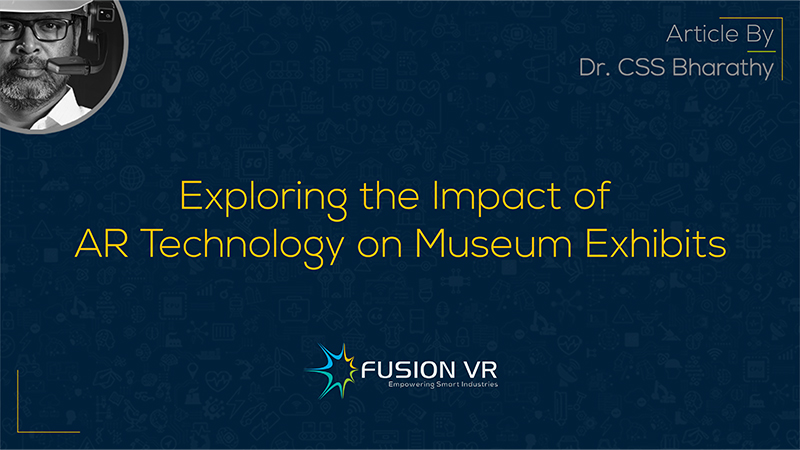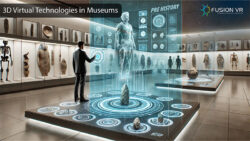Technologies have made a forceful impact on the overall visitor experience in museums worldwide. It has enabled many improvements to the preservation, display and ongoing research on valuable artifacts. In addition to that, technology is making important contributions in the development and installation of interactive exhibits in the museum. Museums are in the throes of a massive transformation from traditional approaches towards increased digitalization and interactive museum experiences. The technologies available today are also becoming increasingly affordable to install and maintain within museums. There is a vibrant ecosystem that is also supporting this transformation. The impact of technology on museums is something that we will explore here in greater detail for the benefit of everyone.
A few of the most exciting technologies that are being deployed in museums today include virtual reality (VR) and augmented reality (AR). Of these two AR is making rapid strides in its adoption in museums. Augmented reality for those not familiar with it is a cool technology that is available on everyday devices such as smartphones and tablets. Using an application, augmented reality enables the overlay of digital content on the reality that we witness through these devices. The overlaid information is contextual, relevant and highly interactive. The quality of a visitor’s experience using augmented reality is many times more than one that is without.
Augmented reality makes it more interesting for any visitor due to the interactive and immersive aspects that it provides. One could compare a visit to the museum by yourself and with a friend. The companionship during that visit provides the ability to interact with your friend, generates new information, insight, jokes, laughter and definitely makes the experience more memorable. Augmented reality helps to be that friend which enhances your experience and makes it more memorable. This technology provides much more interactive content than even a friend would, though the human touch from a friend is unmatched.
The impact of augmented reality in museums is immense. All you need is to get started with installing the museum AR application on your smartphone. With this and a high-quality headset, you are fully equipped to get the full experience. Applications are designed by a team of creative professionals, museum experts and AR developers with exciting UI/UX skills that deliver a fantastic experience inside the museum.
In the very first instance, augmented reality brings every exhibit at the museum to life in front of your eyes. This experience creates a captivating impact on the visitor. Let’s say you walk past a Chola age bronze statue and you are intrigued by who created it and from which century. Typically, there is a label next to the exhibit that provides that information. However, if there are a few people milling around it, you may wish to avoid bothering them or crashing in. With that your curiosity dies and the opportunity to appreciate that Chola bronze.
However, if you have the AR application, the thoughtful AR app designer has helped to generate a voice or visual prompt, asking you if you would be interested in more details. The application recognizes your location in the museum in conjunction with the location of the exhibit and generates that prompt. If your answer is in the affirmative, the AR application provides a menu for you to make your choices. Would you like to read more about the exhibit? Would you like to watch a video to learn more about it? Or would you like to watch a highly realistic 3D model of it and turn it around to see it from all angles? Or do you want to scan the exhibit and generate visual cues about each part of the exhibit? These are the multitude of options that change the way a visitor experiences just one exhibit. This is a transformative experience delivered by augmented reality. The interactive features provide the best value for a visitor’s time and money.
Augmented reality has impacted the way the museum is experienced in another way. AR allows for time travel. How many of us longed to witness a historical event after reading it in a text? Events in the 19th century and before were captured only in texts or paintings. We have had to use our imagination to wonder what those times were like. Augmented reality can bring to life the past like we have never experienced before. Imagine diving into the past to witness the great battles and expeditions of Chhatrapati Shivaji. As your device camera scans a painting, a highly realistic 3D animation springs in front of your eyes and re-enacting the battle formations and maneuvers of the great king and commander. This is history in motion and delivers an exhilarating experience only rivaled by an action thriller.
This has made the Augmented reality museum experience more personal. With the advent of social media, we can record ourselves along with the exhibit and share with family and friends. Imagine viewing sculptures or busts of famous leaders. What if you walk into Madame Tussauds wax museum and would like to take a picture with a celebrity there? You may not be able to get very close personally and run the risk of ruining it. But AR applications allow the visitor to take a selfie with any celebrity on display. The application digitally merges you into the picture, making it highly realistic. Your friends may think it was a real picture taken with the real celebrity and briefly making you a minor celebrity in your community
The interactive nature of Augmented reality museum exhibits has a huge impact on young children. These exhibits deliver content that engages them in creative ways. The National Museum of Singapore has an interactive AR exhibit called the Story of the Forest which has 69 images of the William Farquhar Collection of National History which have been transformed into three-dimensional images that come to life with an AR application. Museums can also bring to life what their cities looked like decades ago. Many cities transform themselves with new developments that present a very different look. This is also a trip down memory lane for the older residents to reminisce about how the city looked many years ago. AR helps to overlay the old view on existing buildings and spaces, bringing to life those memories.
Museums are not alone in establishing AR exhibits. Many corporations are investing in developing corporate experience centers that showcase the history of their organization. Maybe these were important companies which contributed to the development of the nation and presented a unique addition to history. Fusion VR is a pioneer in both the museum and corporate experience center space in India. Our expertise is on display at museums in Chennai and Kolkata and many new exciting projects are in the pipeline. A visit to our Museum 2.0 webpage would open the door to learning more about the impact of augmented reality in museum exhibits.
Augmented reality is being adopted rapidly in the museum and other sectors. We encourage museum professionals and visitors to develop use cases on newer ways to deploy AR in museum exhibits and experiences. The talent to develop solutions for these use cases is readily available in the country. A beautiful collaboration can be achieved by bringing in various stakeholders to create enduring interactive AR exhibits. In a short time, we will witness the magic of AR in various facets of daily life, entertainment, education, workplaces etc. and create a huge impact in improving the experience of everyone.





